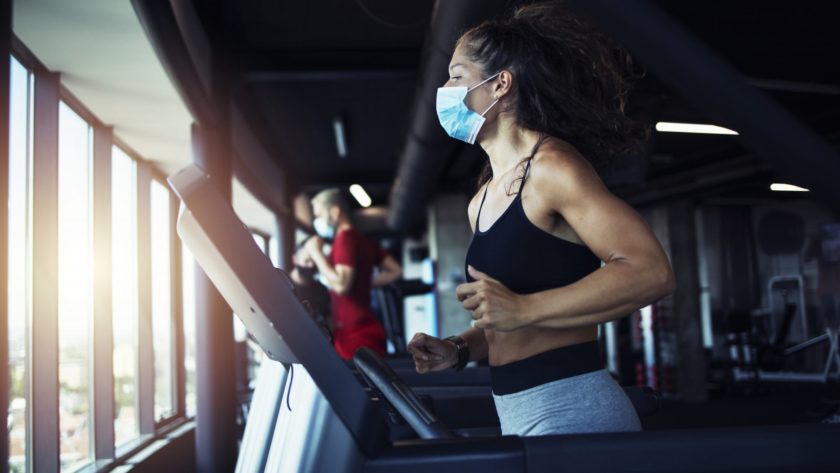For the past few months, people have been exercising inside their homes, but as gyms and studios reopen and as antsy as many are to get back to their workout routines, they wonder how safe it is to return to their favorite faciility. While masking is the key to protecting yourself, here are some safety do’s and don’ts when exercising with a mask.
How Covid-19 Can Spread at a Gym
The Factors:
- More viral particles (through aerosolized droplets) expelled into the air. People breathe harder (more rapidly and deeply) when exercising. The moist, warm air combined with turbulent air flow (forced exhalations) from exercising can cause droplets within the environment to spread more easily.
- Number of people in the class and the intensity of the workout can affect transmission.
- Air conditioning vs natural cross-ventilation. If aerosolized droplets remain airborne, there is greater potential for the virus to spread in a crowded, confined space and through re-circulated air.
- Exercise-induced rhinitis (the nose runs when exercising). This is common among athletes and 24%-74% have it.
The Solution: Masking during exercise — but this create a problem of its own.

The Do’s and Don’ts on Wearing a Mask During Exercise
1. DO make sure your mask is big enough. It should cover your nose and face and comfortable, yet snug around cheeks and nose. BUT…covering your nose and mouth while exercising makes it harder to inhale the quantity of air needed by your working muscles.
Exercising results in harder and more rapid breaths to accommodate the need for more oxygen and to expel carbon dioxide. (Working muscles produce lactic acid, a.k.a. ‘the burn’, which is converted to carbon dioxide and exhaled into mask.)
A mask can increase resistance to airflow causing increased heart rate, shortness of breath, dizziness, lightheadedness, and headache. A common complaint is the mask suctions to the face and mouth, especially when exhaling and inhaling more forcefully.
2. DON’T touch your mask. If you do, disinfect your hands.
3. DON’T exercise with a mask if you have health conditions. Don’t exercise with a mask if you are pregnant, have a type 2 diabetes, a pre-existing cardiovascular or respiratory condition, such as:
- COPD (chronic obstructive pulmonary disorder)
- Asthma
- Chronic bronchitis
- Pulmonary fibrosis
- Any other lung conditions
4. DO bring extra masks and replace it when it becomes damp. Sweat makes a mask less porous. A wet mask increases resistance to air flow in both directions. Wet masks increase venting (area around the sides of the mask) and promote growth of microorganisms. When it’s harder for air to exchange in either direction, you may feel lightheaded and ‘suffocated’. Masks can be uncomfortable when exercising.
5. DO know when to stop exercising. STOP exercising when symptoms occur, and remove your mask to increase flow of oxygen to the lungs. Get out into fresh air if possible. Get immediate medical attention if symptoms persist.
6. DON’T exercise at high-intensities without adapting gradually. Since oxygen concentration is diminished when exercising with a mask (similar to exercising at a high altitude), you may be feel more fatigued during and after the workout and may be unable to perform your “normal” routine.
Very demanding exercises, such as high-intensity interval training (HIIT), should be performed with caution or avoided altogether. Don’t push yourself as hard as usual. You will require more oxygen to maintain the exercise intensity and duration, and may experience symptoms from the reduced amounts of oxygen reaching the vigorously exercising muscles.
Karen’s Fit Tip: If your heart is set on returning to the gym, consider your own risk factors (age and underlying health conditions). Stay tuned! More Do’s and Don’ts in our next KRON4 segment.





